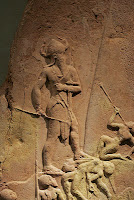More Woodhenge.
When I sat down to write this, the protractor was still stuck to the monitor. I'd left it there a couple of nights ago, when trying to make head or tail out of this diagram.
This picture is troublesome because the line continued along the points A and B (as drawn by Maud Cunnington) is supposed to make an angle or azimuth in this case of 49.2..
Well midsummer sunrise (this year) was at an azimuth of 49 degrees, but an azimuth is measured from the North. Putting or finding a 49 degree angle within the posts of Woodhenge, even if you have a bright red triangle, is not -well, not to me- significant.
The 49 degree angle in this picture is drawn between the position of midsummer sun rise and the line B, C. The red triangle may or may not be significant, all I know is I don't think anyone making Woodhenge would bother using Pythagorean theories, primarily and very significantly; because there is no need!
Anyway, this diagram was about me wasting time.
What I wanted to do was to print out the shape of Woodhenge and then draw moon and sun positions to show how they moved around the monument, I became distracted by this one because I couldn't see for the life of me why....just why really!
Why the triangles, why make it seem complex and difficult and scientific in a mathematical way...
And why the fixation on midsummer sunrise?
The Midsummer sunrise doesn't seem to be a terribly useful kind of thing. It may mean it's time to harvest things, but you could tell that by looking at the crops. It means winter is coming, but the autumn equinox will prove that. Both May day and Midsummer are mythologically speaking a time for party, but it is May day that is traditionally the time for the sap to rise and -I don't want to use this word- fertility. At Midsummer the nights are long, and nothing much needs to be done. If Midsummer was a time for party; which I kind of have trouble imagining, then speaking as a woman, a Midsummer romp makes more sense than May day...because a Midsummer party and resulting pregnancy would mean giving birth in March.
As far as the weather and food supply is concerned, March is better than January (get pregnant at Beltane- 1st of May and deliver your child in January, surely that's going to be tough?)
So Midsummer as a massive fertility ritual...er...let's move on.
Why else would Midsummer be significant?
Or is a Midsummer alignment coincidental, at a similar azimuth to something else?
Woodhenge isn't a good party place -that was Durrington, next to. Apparently it was a winter party there- but perhaps this party thing, especially the Stonehenge version is a very 20th Century imposition over a landscape we only dimmly recall? I have a feeling that the first Midsummer Stonehenge parties began in my lifetime, and the Druids turned up some seventy decades before, in 1905. Stonehenge and its Midsummer party may not be as old as some people like to believe.
But, back to Woodhenge, the angle from Maud's line of A, B to North is closer to 41 degrees, an angle much closer to a midwinter moon rise -when the moon is at it's maximum position (once every 18.6 years or something like that).
A Midwinter full moon party, with roast pork would be more in keeping with tradition, I think.
In 2006 the midwinter full moon rose at 41 degrees, but where the moon was four thousand years ago, or how the sight is affected by the lay of the land, I do not know. It is quite hard to get solid and reliable information about anything at all, I find.
So, a compass is in the post to me and my place in the library at Devizes museum awaits.
Woodhenge is cut and pasted as a site of human sacrifice:
And finally, Woodhenge itself has become interesting.
This picture is troublesome because the line continued along the points A and B (as drawn by Maud Cunnington) is supposed to make an angle or azimuth in this case of 49.2..
Well midsummer sunrise (this year) was at an azimuth of 49 degrees, but an azimuth is measured from the North. Putting or finding a 49 degree angle within the posts of Woodhenge, even if you have a bright red triangle, is not -well, not to me- significant.
The 49 degree angle in this picture is drawn between the position of midsummer sun rise and the line B, C. The red triangle may or may not be significant, all I know is I don't think anyone making Woodhenge would bother using Pythagorean theories, primarily and very significantly; because there is no need!
Anyway, this diagram was about me wasting time.
What I wanted to do was to print out the shape of Woodhenge and then draw moon and sun positions to show how they moved around the monument, I became distracted by this one because I couldn't see for the life of me why....just why really!
Why the triangles, why make it seem complex and difficult and scientific in a mathematical way...
And why the fixation on midsummer sunrise?
The Midsummer sunrise doesn't seem to be a terribly useful kind of thing. It may mean it's time to harvest things, but you could tell that by looking at the crops. It means winter is coming, but the autumn equinox will prove that. Both May day and Midsummer are mythologically speaking a time for party, but it is May day that is traditionally the time for the sap to rise and -I don't want to use this word- fertility. At Midsummer the nights are long, and nothing much needs to be done. If Midsummer was a time for party; which I kind of have trouble imagining, then speaking as a woman, a Midsummer romp makes more sense than May day...because a Midsummer party and resulting pregnancy would mean giving birth in March.
As far as the weather and food supply is concerned, March is better than January (get pregnant at Beltane- 1st of May and deliver your child in January, surely that's going to be tough?)
So Midsummer as a massive fertility ritual...er...let's move on.
Why else would Midsummer be significant?
Or is a Midsummer alignment coincidental, at a similar azimuth to something else?
Woodhenge isn't a good party place -that was Durrington, next to. Apparently it was a winter party there- but perhaps this party thing, especially the Stonehenge version is a very 20th Century imposition over a landscape we only dimmly recall? I have a feeling that the first Midsummer Stonehenge parties began in my lifetime, and the Druids turned up some seventy decades before, in 1905. Stonehenge and its Midsummer party may not be as old as some people like to believe.
But, back to Woodhenge, the angle from Maud's line of A, B to North is closer to 41 degrees, an angle much closer to a midwinter moon rise -when the moon is at it's maximum position (once every 18.6 years or something like that).
A Midwinter full moon party, with roast pork would be more in keeping with tradition, I think.
In 2006 the midwinter full moon rose at 41 degrees, but where the moon was four thousand years ago, or how the sight is affected by the lay of the land, I do not know. It is quite hard to get solid and reliable information about anything at all, I find.
So, a compass is in the post to me and my place in the library at Devizes museum awaits.
Woodhenge is cut and pasted as a site of human sacrifice:
"One and a half metres from the actual centre, the skeleton of a child of about three years of age was exhumed from the chalk, its skull cleaved open in what was almost a predetermined act. This according to experts, is one of the very few pieces of evidence of human sacrifice in prehistoric Britain".Has the word *certainly* gone missing from that cut and paste? I think it is a quote from Aubrey Burl and the line should read:
"what was almost *certainly* a predetermined act".My meander around Woodhenge centers on the interpretation of that find; if it is true, if she was a three year old child killed at the center of the ring, what was the mythology that made her death acceptable to her community? Secondly, why has the modern interpretation of this find changed so that now she is a precious 'accident' given a resting place of honour?
And finally, Woodhenge itself has become interesting.


